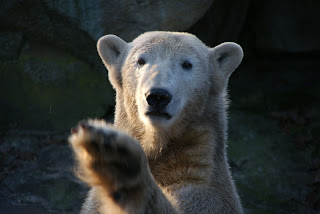 |
| Knut as a baby. Source: Wikimedia Commons |
Yes, I am posting a memorial piece for a polar bear. Yes, I know that I talk about polar bears too much. But, this really is an interesting case of mysterious death – one that was witnessed by hundreds and has cause an onslaught of media coverage of what may very well be history’s most widely read polar bear obituary.
Knut was a polar bear born in captivity in the Berlin Zoo in December of 2006. He gained world wide fame, basically for being so darn cute. He was raised by the zookeepers after being rejected by his mother and was the first polar bear to survive infancy at the Berlin Zoo in 30 years. He died March 19, 2011 in his enclosure at the zoo in front of an estimated 700 viewers. His death has been the subject of worldwide media coverage from the UK’s Daily Mail to New York Magazine.
Reports say that the polar bear had a spasm, and was then seen floating in the water in the enclosure before the exhibit was closed off by zoo personnel. Polar bears in captivity have been known to live up to 30 years, and Knut was not known to have any medical problems so his sudden death at age four is mysterious. A necropsy (an autopsy for animals) will be performed to determine what happened to the bear.
 |
| Knut a little older. Source: Wikimedia Commons |
As far as polar bears go, you couldn’t have a bigger celebrity than Knut. He was on the cover of Vanity Fair in 2007, he has been marketed through plush toys and children’s books, he was the subject documentary films and even had his name trademarked by the Berlin Zoo. His untimely death even warranted him an obituary in People Magazine’s website.
While I don’t intend to get sappy about the loss of this animal, I do think it is important to note because Knut succeeded in getting people to feel emotionally invested in animal rights issues and to get people talking about science topics like climate change (and its effects on polar bears). He was a major draw to the Berlin Zoo and the loss of revenue will most certainly be felt. Hopefully the necropsy will be able to determine how he died so that zookeepers can learn something about how to keep animals in captivity healthy.
***
Update 4/1/11 – The Berlin Zoo has released the results of Knut’s necropsy. The findings show that the polar bear’s official cause of death is drowning, which occurred when he collapsed into the pool in his enclosure. The reason Knut collapsed is still a bit of a mystery. The necropsy showed encephalitis (brain swelling and irritation) most likely caused by a virus, although the exact virus remains to be identified. So far rabies, botulism, and bovine spongiform encephalopathy (mad cow disease) have been definitively ruled out as the cause of the brain swelling. The zoo will continue to test Knut’s remains to try to identify the virus.

